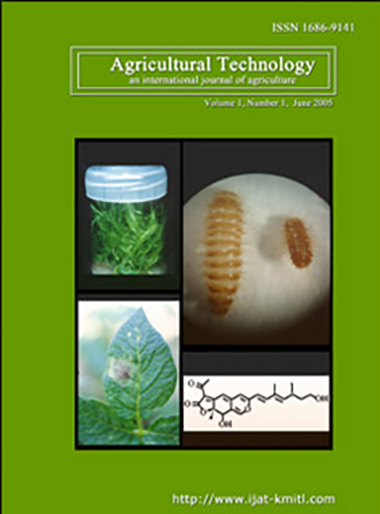Evaluation of anamorphic state, wood decay and production of lignin-modifying enzymes for diatrypaceous fungi from Argentina
Main Article Content
Abstract
Morphological descriptions, wood decay and anatomical criteria, production of ligninolytic and cellulolytic enzymes and melanin production of diatrypaceous species (Eutypella andicola, E. comosa, E. leprosa and E. scoparia) from Argentina were investigated. The anamorphic state of Eutypella andicola is described for the first time. The morphological characteristic of the anamorphs were similar among all strains. Most isolates were capable of causing mass loss in Populus deltoides wood blocks during a 12-week period. Differences among strains were significant. The anatomical observations demonstrated that in a first state of wood colonisation this fungi produced soft rot decay and in later colonisation state the decay type is similar to white rot. Extracellular production of ligninolytic and cellulolytic enzymes were studied by mycelium growing on solid medium supplemented with different dyes (Malachite green, Azure B, Poly R-478, Congo red, tannic and galic acid, and guayacol). Seven of the eight strains analysed decolourised all the dyes except for the Malachite green. Only one strain of E. scoparia was able to decolourise Malachite green. Through simple assays we established the production of “extracellular melanins” and its association to growth areas of the fungus and discoloration zones.
Article Details

This work is licensed under a Creative Commons Attribution-NonCommercial-NoDerivatives 4.0 International License.
References
Bell, A.A. and Wheeler, M.H. (1986). Biosynthesis and function of fungal melanins. Annual Review of Phytopathology 24: 411-455.
Bucher, V.V.C., Hyde, K.D., Pointing, S.B. and Reddy, C.A. (2004). Production of wood decay enzymes, mass loss and lignin solubilization in wood by marine ascomycetes and their anamorphs. Fungal Diversity 15: 1-14.
Carmarán, C.C. (2002). Contribución al estudio del orden Diatrypales en las zonas subtropicales de la República Argentina. Boletín de la Sociedad Micológica de Madrid 26: 43-56.
Carmarán, C.C. (2003a). First contribution to the study of Cryptosphaeria from Argentina. Fungal Diversity 12: 161-167.
Carmarán, C.C. (2003b). Thesis. Contribución al conocimiento de la familia Diatrypaceae, Biodiversidad y taxonomía. PhD thesis. Universidad de Buenos Aires, Argentina.
Carmarán, C.C: and Romero, A.I. (1992). Problemas taxonómicos en el orden Diatrypales. Contribución a su esclarecimiento I. Boletín de la Sociedad Argentina de Botánica 28: 139-150.
Chacon, S. (2002). Taxonomic notes on the genus Endoxylina (Diatrypales, Ascomycotina) and description of a new species from Mexico. Fungal Diversity 11: 61-68.
Cripps, C., Bumpus, J.A. and Aust, S.D. (1990). Biodegradation of azo and heterocyclic dyes by Phanerochaete chrysosporium. Applied and Environmental Microbiology 56: 1114- 1148.
Croxall, H.E. (1950). Studies on British Pyrenomycetes III. The British species of the genus Diatrypella Cesati & De Notaris. Transactions of the British Mycological Society 33: 45-72.
Duncan, C.G. and Eslyn, W.E. (1966). Wood decaying ascomycetes and fungi imperfecti. Mycologia 58: 642-645.
Fengel, D. and Wegener, G. (1984). Wood: Chemistry, Ultrastructure, Reactions. Walter de Gruyter, Berlin, Germany.
Gadd, G.M. (1982). Effects of media composition and light on colony differentiation and melanin synthesis in Microdochium bolleyi. Transaction of the British Mycological Society 78: 115-122.
Glawe, D.A. (1984). Cryptosphaeria pullmanensis, a new species from Washington state. Mycologia 76: 166-169.
Glawe, D.A. and Rogers, J.D. (1982). Observation on the anamorph of six species of Diatrype and Diatrypella. Canadian Journal of Botany 60: 245-255.
Glawe, D.A. and Rogers, J.D. (1984). Diatrypaceae in the pacific Northwest. Mycotaxon 20: 401-460.
Glawe, D.A. and Rogers, J.D. (1986). Conidial states of some species of Diatrypaceae and Xylariaceae. Canadian Journal of Botany 64: 1493-1498.
Glawe, D.A. and Jacobs, K.A. (1987). Taxonomic notes on Eutypella vitis, Cryptosphaeria populina and Diatrype stigma. Mycologia 79: 135-139.
Holmgren, K.P., Holmgren, N.H and Barnett, L.C. (1990). Index Herbariorum. Part I: The Herbaria of the World. New York Botanical Garden. New York, USA:
Kirk, T.K. and Farrell, R.L. (1987). Enzymatic “combustion”: the microbial degradation of lignin. Annual Review of Microbiology 41: 465-505.
Kirk, P.M., Cannon, P.F., David, J.C. and Stalpers, J.A. (2001). Dictionary of the Fungi. 9th ed. Ainsworth & Bisby's CAB International Wallingford, UK.
Merrill, W., French, D.W. and Wood, F.A. (1964). Decay of wood by species of the Xylariaceae. Phytopathology 54: 56-58.
Nilsson, T. (1973). Studies on wood degradation and cellulolytic activity of microfungi. Studia Forestalia Suecica 104: 1-40.
Nilsson, T., Daniel, G., Kirk, T.K. and Obst, J.R. (1989). Chemistry and microscopy of wood decay by some higher ascomycetes. Holzforschung 43: 11-18
Podgornik, H., Poljansek, I. and Perdih, A. (2001). Transformation of Indigo Carmine by Phanerochaete chrysosporium ligninolytic enzymes. Enzyme Microbiology and Technology 29: 166-172.
Rappaz, F. (1987). Taxonomie et nomenclature des Diatrypacees a asques octospores. Mycologia Helvetica 2: 285-648.
Rodriguez, E., Pickard, M.A. and Vazquez-Duhalt, R. (1999). Industrial dye decolorization by laccases from ligninolytic fungi. Current Microbiology 38: 27-32.
Romero, A.I. and Minter, D.W. (1988). Fluorescence microscopy: An aid to the elucidation of Ascomycete structures. Transactions of the British Mycological Society 90: 457-470.
Samuels, G. and Candoussau, F. (1996). Heteronetly in the Calosphaeriales: a new Calosphaeria with Ramichloridium- and Sporothrix-like synanamorphs. Nova Hedwigia 62: 47-60.
Savory, J.G. (1954). Breakdown of timber by Ascomycetes and Fungi Imperfecti. Annual of Applied Biology 41: 336-347.
Seifert, K.A. (1983). Decay of wood by the Dacrymycetales. Mycologia 75: 1011-1018.
Smith, D. and Onions, A.H.S. (1994). The Preservation and Maintenance of Living Fungi, second edition. IMI technical handbooks: No. 1, CAB International. Wallingford, UK.
Spadaro, J.T., Gold, M.H. and Renganathan, V. (1992). Degradation of azo dyes by the lignindegrading fungus Phanerochaete chrysosporium. Applied and Environmental Microbiology 58: 2397-2401.
Stalpers, J.A. (1976). Identification of wood-inhabiting fungi in pure culture. Studies in Mycology 16: 1-248.
Suryanarayanan, T.S., Ravishankar, P., Venkatesan, G. and Murali, T.S. (2004). Characterisation of the melanin pigment of a cosmopolitan fungal endophyte. Mycological Research 108: 974-978.
Tiffany, L.H. and Gilman, J.C. (1965). Iowa Ascomycetes IV. Diatrypaceae. Iowa State Journal of Science 40: 121-161.
Worrall, J.J., Anagnost, S.E. and Zabel, R.A. (1997). Comparison of wood decay among diverse lignicolous fungi. Mycologia 89: 199-219.


